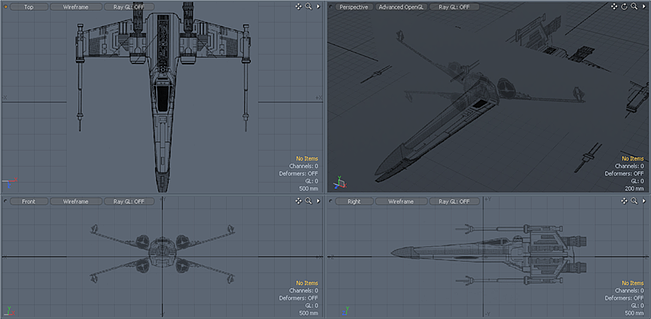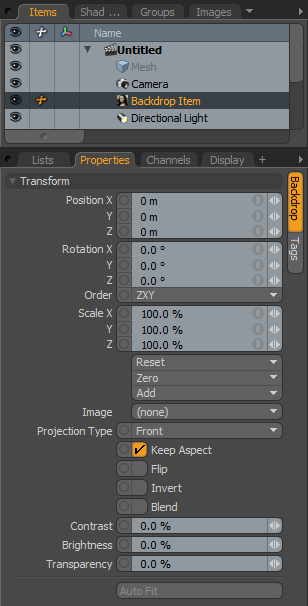Backdrop items are terrific modeling aids allowing users to add images into a background plane that acts as reference for geometry creation. This can be a photograph, a line drawing or even blueprints. As Backdrop Items are only meant for reference they will not contribute to rendered output. Best of all, since they are items in the item list, they are saved with the scene and can be manipulated with the standard transform tools.

To add a background image users can use the menu bar command "Item > Create Backdrop" which creates a new Background item layer in the Item List. Users can then select the newly created layer and further define the backdrop settings within its associated properties panel, where users set the image, orientation and adjust its image properties (detailed below). Once users have defined a number of different views, it is handy to group them together using the 'Ctrl+G' keyboard shortcut providing users the ability to toggle the all of the Backdrop images visibility with a single action.
Backdrop Item
 Transform--
Transform--
Position: The 'Position' setting allows the user to specify a numeric XYZ values for the placement of the backdrop image within the viewport. All transforms originate from the planes center point.
Rotation: With 'Rotation' you can adjust a backdrop items rotation in the viewport, however in most instances, it would be best to simply adjust the 'Projection Type' to position the image toward a specific viewport.
Order: Allows the user to set the order that rotations are applied to the camera item. Changing the order that rotations are applied can sometimes help to reduce or eliminate gimbal lock.
Scale: The 'Scale' function allows the user to adjust the size of the backdrop items.
Reset: Resets the selected transform values to (0,0,0) returning the items back to the world space center position.
Zero: Returns the items Center position to the world space center (0,0,0) without changing the position of the backdrop item itself.
Add: The 'Add' function will add the selected set of transforms to the channel list. Useful when animating complex motions, providing a layered approach to the transforms. Since Backdrops don't render, this setting is unnecessary.
Image: Click in the image drop down to specify an image or use the load command to load an image from disc.
Projection Type: The 'Projection Type' setting allows the user to specify which viewport the backdrop image will face toward as well as a 'Camera' projection mode that appears automatically in the background of any Viewport set to 'Camera' as the type. For multiple viewports, such as front, side and back, three different backdrop items would need to be created with the appropriate image and projection type specified for each.
Keep Aspect: The 'Keep Aspect' function will retain the aspect ratio of an image when it is scaled.
Flip: The 'Flip' command will mirror the images pixels across the vertical axis, useful for using the same image for front and back pairs or left and right pairs.
Invert: The 'Invert' toggle will invert the RGB values for the backdrop image, useful when inverting a black and white line drawing to make the lines more visible.
Blend: The 'Blend' function will produce a small amount of smoothing between neighboring pixels, reducing the jagged appearance of low resolution images.
Contrast: Contrast is the apparent visual different between light and dark values in an image. Values greater than 0% will increase the contrast of the backdrop image, while values lower than 0% will decrease it.
Brightness: Brightness is the degree or amount of light or luminosity in an image. Values greater than 0% will increase the brightness of the backdrop image, while values lower than 0% will decrease it.
Transparency: Transparency determines the opacity of the backdrop image. Values greater than 0% will increase the transparency, ramping toward 100% where the image would become completely invisible.
Auto Fit: The 'Auto Fit' command will automatically scale the Backdrop item to match the height of the currently active mesh items, or the height and width when 'Keep Aspect' is disabled. However, this will only work when 'Display Backdrop Items in Uniform Size' is enabled in the preferences file. To find it, click in the menu bar "System > Preferences' and then in the preferences window, select the 'Display > OpenGL' section, backdrop items are listed toward the bottom.
TIP: Within modo's 'Preferences', there are a few options related to Backdrop items and how modo scales images when placing them. For more information, please reference the appropriate Preferences page of the documentation.


